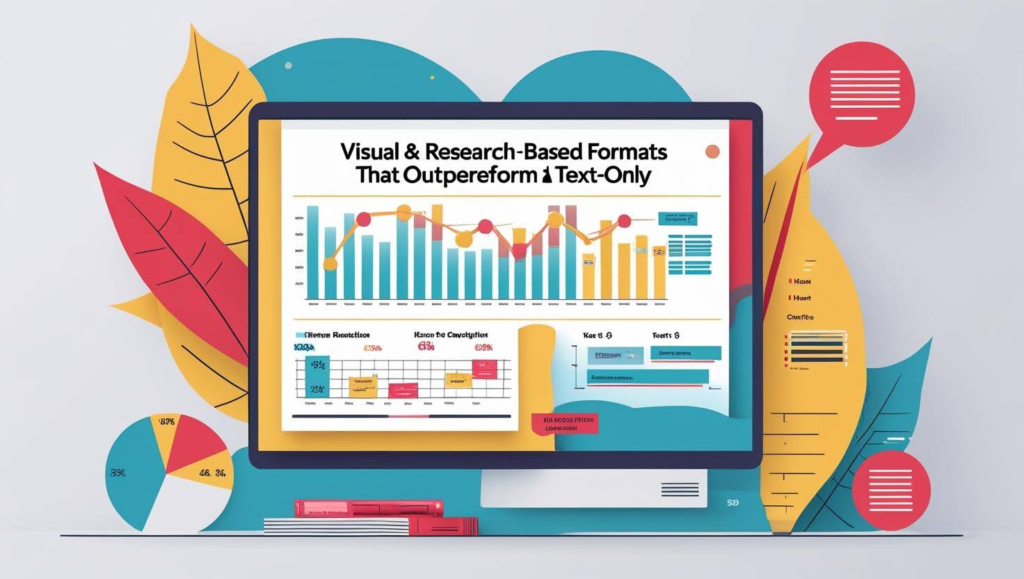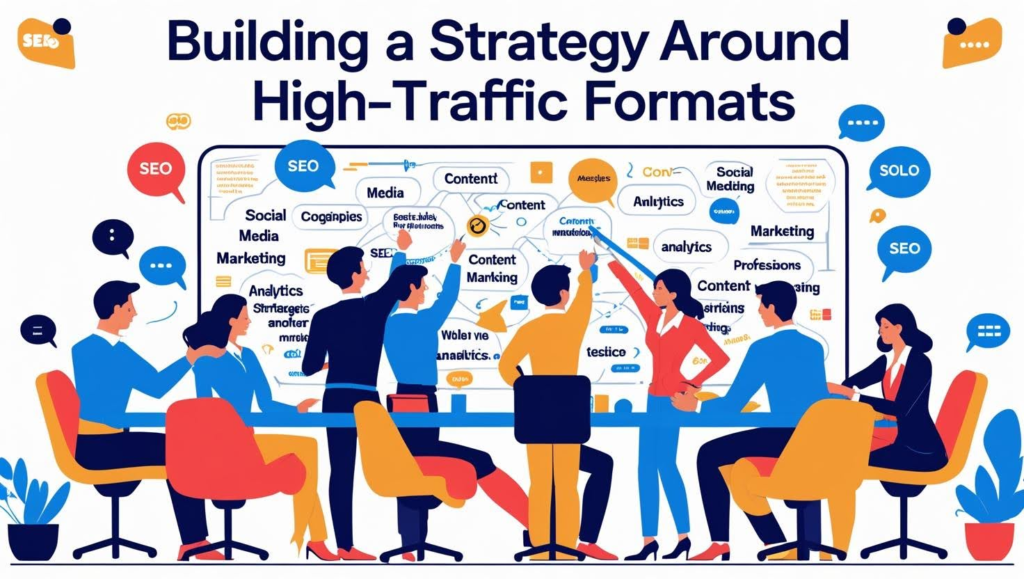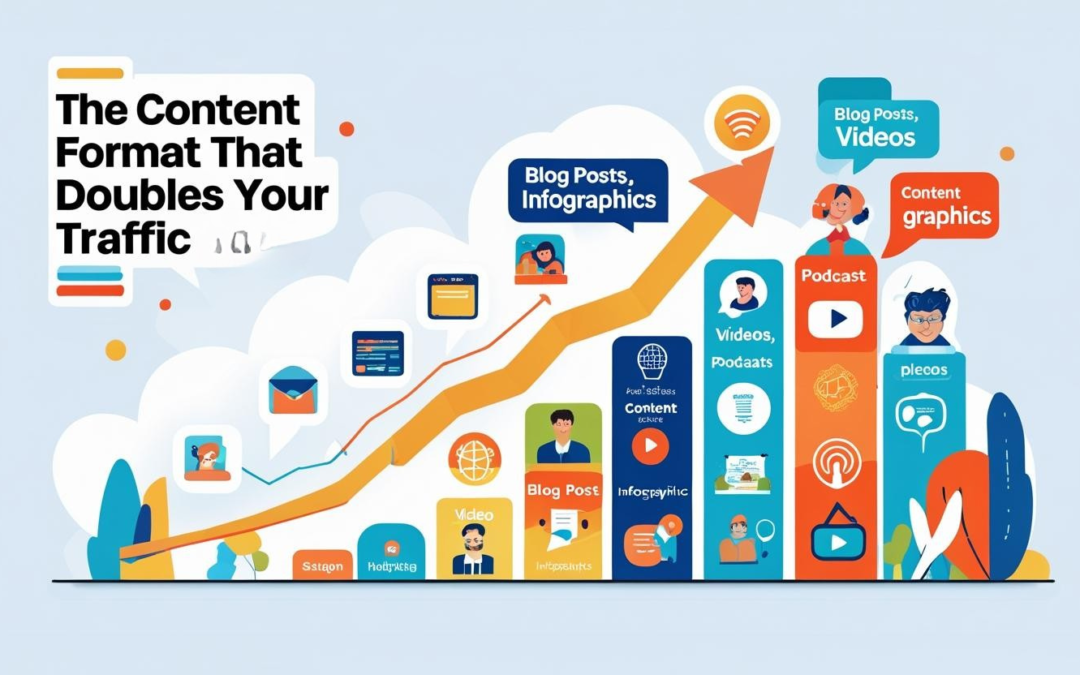1. Introduction
Imagine stepping into a noisy digital marketplace. Every stall is shouting for attention—blogs, ads, emails, memes—yet people keep walking by. Then, suddenly, one creator speaks in a way that makes the crowd stop. People lean in. They listen. They click. They share.
That’s the power of the right content format.
Right now, one type of content is getting that crowd-stopping attention far more often than others: short-form video. But here’s the catch—it’s not the only player in the game. When you layer short videos with data-rich visuals, interactive tools, authentic stories, and ongoing research, you create a content ecosystem that not only gets clicks but also keeps people coming back.
Think of this article as your backstage pass. We’ll break down why certain formats are outperforming others, how to make them work together, and where this whole content world is headed.
Key Points at a Glance
- Short-form video is currently the single most powerful content format for traffic growth, delivering up to 2× more engagement than traditional content.
- Other formats—infographics, original research, interactive tools, case studies, and podcasts—act as amplifiers to build authority, increase dwell time, and earn backlinks.
- Combining multiple high-impact formats in a content cluster strategy multiplies results, rather than relying on one format alone.
- The future of high-traffic content is shorter, more visual, and more interactive—but rooted in valuable, original insights.
2. Why Short-Form Video Is Dominating and Doubling Traffic
Short-form videos—usually 15 to 60 seconds—are not just for TikTok dances anymore. Platforms like Instagram Reels, YouTube Shorts, and even LinkedIn are pushing bite-sized video content to the top of feeds. And the numbers are impossible to ignore:
- 73% of consumers now prefer short videos when learning about products (Lifewire, 2024).
- Short-form video delivers 2× the engagement rate of long-form content on average.
- Many brands see a 30–50% uplift in conversions when using short video in ad campaigns.
Why it works:
- Micro-learning: Our brains like digestible chunks of information. A 20-second clip with one core message is easier to remember.
- Platform algorithms: TikTok, Reels, and Shorts reward completion rates. Short videos are easier to watch until the end, boosting your visibility.
- Repurposing ease: One shoot can create dozens of micro-clips, perfect for multi-platform posting.
Pro Tip: Treat short-form videos as trailers for your longer content. A 30-second “hook” can lead viewers to a full blog post, webinar, or download.
3. Visual & Research-Based Formats That Outperform Text-Only

Infographics: Turning Data Into Digestible Gold
Infographics take dense topics and transform them into eye-catching, shareable content. According to HubSpot, infographics are three times more likely to be shared than other types of content. They also earn more backlinks, which directly improves SEO.
Why they’re effective:
- Visual processing: The human brain processes visuals 60,000 times faster than text.
- Shareability: Social platforms favor visual content in their algorithms.
- Authority: Infographics that use original data make you the go-to source in your niche.
Example: A marketing agency creates an infographic called “The 10 Biggest Social Media Mistakes in 2025” using its own research. It gets shared across LinkedIn groups, cited in blogs, and used in presentations—bringing hundreds of referral visitors.
Original Research & Data Reports: Becoming the Source
If infographics are the bite-sized snack, research reports are the full meal. Publishing original studies, industry surveys, or benchmarking reports gives you a unique asset no competitor can duplicate.
Benefits:
- Backlinks magnet: Journalists and bloggers cite data sources.
- Trust builder: You’re not just commenting on trends—you’re documenting them.
- Evergreen traffic: Well-researched reports get shared for years.
Example: An SEO software company publishes a “State of Search 2025” report. Every time a marketer writes about SEO trends, they link back to that report.
4. Interactive Formats That Keep People Clicking
Calculators & Tools: Instant Value in Action
Interactive tools solve problems in real time. Examples include ROI calculators, mortgage estimators, or “find your ideal plan” selectors.
Why they work:
- Personal relevance: Users input their data, so the result feels tailored.
- Longer dwell time: People spend more time engaging with the tool.
- Lead capture: Tools can offer results in exchange for an email address.
Example: A fitness brand offers a “Calorie Burn Calculator” that tells you how many calories you burn doing different workouts. It’s useful, shareable, and branded.
Quizzes & Polls: Fun That Spreads
Buzzfeed-style quizzes still work—if they align with your brand. Personality quizzes, skill assessments, or readiness tests can go viral.
Why they work:
- Curiosity hook: People want to know, “Which type am I?”
- Social sharing: People post results, pulling friends into the funnel.
- Segmentation tool: You can group quiz takers into different marketing segments.
Example: A skincare brand runs a quiz: “What’s Your Skin Personality?” At the end, users get a product recommendation and a discount code.
5. Storytelling Formats That Build Trust
Case Studies: Proof in Action
Case studies are business storytelling at its best. They follow the “challenge → solution → results” arc and highlight real clients.
Why they work:
- Relatability: Prospects see themselves in the success story.
- Credibility: Backed by data and testimonials.
- Sales tool: They bridge the gap between interest and purchase.
Example: A B2B SaaS company shows how one client increased revenue by 40% using their tool, with specific numbers and quotes.
Podcasts: The Voice of Authority
Podcasts let you speak directly into your audience’s ear—literally. They build a personal connection in a way that text alone can’t.
Why they work:
- Intimacy: Listeners often tune in during personal moments like commutes or workouts.
- Content multiplier: Every episode can be turned into show notes, blog posts, and clips.
- Networking: Hosting guests expands your reach into their audiences.
Example: A marketing coach starts a weekly podcast interviewing business owners about their growth journeys. Over time, she becomes a recognized name in her niche.
6. Building a Strategy Around High-Traffic Formats

Planning, SEO, and Content Clusters
The secret to sustainable traffic growth is to connect your content formats. A pillar blog (like this one) should link to deeper “child” posts—each optimized for specific keywords. This builds topical authority.
Steps:
- Keyword research: Identify the high-intent queries your audience searches.
- Content calendar: Schedule multiple formats around those topics.
- Internal linking: Tie everything back to your main pillar page.
Repurposing for Maximum Reach
One piece of content can—and should—be turned into multiple assets.
Example:
- A research report → infographic highlights → short video summary → podcast discussion → LinkedIn carousel.
- All of them link back to the main blog or landing page.
This not only stretches your content budget but also ensures you reach people in the format they prefer.
7. Future Trends That Will Shape High-Traffic Content
Looking ahead, three major trends will influence what gets traffic:
- AI-assisted content creation will make visual production faster, allowing brands to create custom graphics, interactive tools, and even AI-generated video at scale.
- Personalization will become table stakes. Content will adapt dynamically based on viewer data.
- Multi-format storytelling will dominate. A single narrative will play out in video, audio, interactive, and text forms—giving users multiple entry points.
8. Conclusion
If you want to double your traffic, think beyond the single magic bullet. Yes, short-form video is the powerhouse right now—but when paired with infographics, original research, interactive tools, and storytelling, you create an ecosystem that keeps pulling people back.
Your strategy should look like a wheel: the hub is your pillar content, and each format is a spoke driving traffic from a different direction. Together, they create momentum that’s hard to stop.
So, start small—pick one format, nail it, then layer in the others. The sooner you start, the sooner you’ll see not just traffic growth, but loyal, engaged audiences who trust you as a go-to resource.

